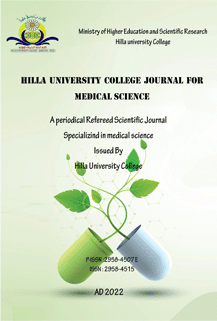Abstract
Background: Sickle cell disease is a monogenetic disorder resulting in early mortality and widespread organ damage,
including pulmonary, cardiac, and splenic dysfunction, as well as cerebral infarcts and avascular osteonecrosis. It results
from a single point mutation causing the replacement of the amino acid glutamic acid by valine. Chronic hemolysis can
affect sickled red cells, chronic in ammation, and oxidative stress, which contribute to the occurrences of vasoocclusion.
Objectives: To measure hematological parameters and their relationship to the development of vasoocclusion.
Materials and Methods: This case-control study was conducted on 80 Iraqi subjects, including 40 cases with sickle cell
disease diagnosed previously by hemoglobin electrophoresis. They were collected from Babylon Teaching Hospital
for Maternity and Children when they attended the Hereditary Blood Disease Center in that hospital. Another 40
subject consider as controls. Three milliliters of venous blood were drawn in EDTA tubes, and investigations were
made immediately at the laboratory of this Hospital by use of hematology analyzer.
Results: Mean leukocytes in SCD were (10.10 ± 4.70) and (7.53 ± 1.80) for controls, showing a signicant difference
(P value 0.002). The mean RBC (3.22 ± 0.97), (4.59 ± 0.58) for patients and control respectively. Mean platelets count
was (358.68 ± 135.82), (286.52 ± 72.95) for patient and control respectively. The mean PCV (26.48 ± 5.71) for patients and
(37.48 ± 5.72) for controls.
Conclusions: There were signicant alterations in RBC, WBC, and platelets between SCD patients and controls.
Hematocrit and hemoglobin were lower in patients than in controls, and even lower during crises than in steady states
including pulmonary, cardiac, and splenic dysfunction, as well as cerebral infarcts and avascular osteonecrosis. It results
from a single point mutation causing the replacement of the amino acid glutamic acid by valine. Chronic hemolysis can
affect sickled red cells, chronic in ammation, and oxidative stress, which contribute to the occurrences of vasoocclusion.
Objectives: To measure hematological parameters and their relationship to the development of vasoocclusion.
Materials and Methods: This case-control study was conducted on 80 Iraqi subjects, including 40 cases with sickle cell
disease diagnosed previously by hemoglobin electrophoresis. They were collected from Babylon Teaching Hospital
for Maternity and Children when they attended the Hereditary Blood Disease Center in that hospital. Another 40
subject consider as controls. Three milliliters of venous blood were drawn in EDTA tubes, and investigations were
made immediately at the laboratory of this Hospital by use of hematology analyzer.
Results: Mean leukocytes in SCD were (10.10 ± 4.70) and (7.53 ± 1.80) for controls, showing a signicant difference
(P value 0.002). The mean RBC (3.22 ± 0.97), (4.59 ± 0.58) for patients and control respectively. Mean platelets count
was (358.68 ± 135.82), (286.52 ± 72.95) for patient and control respectively. The mean PCV (26.48 ± 5.71) for patients and
(37.48 ± 5.72) for controls.
Conclusions: There were signicant alterations in RBC, WBC, and platelets between SCD patients and controls.
Hematocrit and hemoglobin were lower in patients than in controls, and even lower during crises than in steady states
Keywords
: Sickle cell disease
In ammation
Steady state
Vasoocclusive crisis
